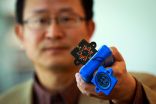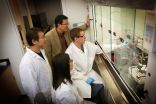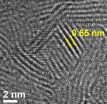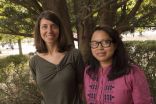(Press-News.org) SALT LAKE CITY, Nov. 4, 2014 – University of Utah engineers have developed a new type of carbon nanotube material for handheld sensors that will be quicker and better at sniffing out explosives, deadly gases and illegal drugs.
A carbon nanotube is a cylindrical material that is a hexagonal or six-sided array of carbon atoms rolled up into a tube. Carbon nanotubes are known for their strength and high electrical conductivity and are used in products from baseball bats and other sports equipment to lithium-ion batteries and touchscreen computer displays.
Vaporsens, a university spin-off company, plans to build a prototype handheld sensor by year's end and produce the first commercial scanners early next year, says co-founder Ling Zang, a professor of materials science and engineering and senior author of a study of the technology published online Nov. 4 in the journal Advanced Materials.
The new kind of nanotubes also could lead to flexible solar panels that can be rolled up and stored or even "painted" on clothing such as a jacket, he adds.
Zang and his team found a way to break up bundles of the carbon nanotubes with a polymer and then deposit a microscopic amount on electrodes in a prototype handheld scanner that can detect toxic gases such as sarin or chlorine, or explosives such as TNT.
When the sensor detects molecules from an explosive, deadly gas or drugs such as methamphetamine, they alter the electrical current through the nanotube materials, signaling the presence of any of those substances, Zang says.
"You can apply voltage between the electrodes and monitor the current through the nanotube," says Zang, a professor with USTAR, the Utah Science Technology and Research economic development initiative. "If you have explosives or toxic chemicals caught by the nanotube, you will see an increase or decrease in the current."
By modifying the surface of the nanotubes with a polymer, the material can be tuned to detect any of more than a dozen explosives, including homemade bombs, and about two-dozen different toxic gases, says Zang. The technology also can be applied to existing detectors or airport scanners used to sense explosives or chemical threats.
Zang says scanners with the new technology "could be used by the military, police, first responders and private industry focused on public safety."
Unlike the today's detectors, which analyze the spectra of ionized molecules of explosives and chemicals, the Utah carbon-nanotube technology has four advantages:
It is more sensitive because all the carbon atoms in the nanotube are exposed to air, "so every part is susceptible to whatever it is detecting," says study co-author Ben Bunes, a doctoral student in materials science and engineering.
It is more accurate and generates fewer false positives, according to lab tests.
It has a faster response time. While current detectors might find an explosive or gas in minutes, this type of device could do it in seconds, the tests showed.
It is cost-effective because the total amount of the material used is microscopic.
INFORMATION:
This study was funded by the Department of Homeland Security, Department of Defense, National Science Foundation and NASA. Zang and Bunes conducted the research with postdoctoral fellow Miao Xu and doctoral student Yaqaiong Zhang.
University of Utah College of Engineering
72 S. Central Campus Dr., Room 1650 WEB, Salt Lake City, UT 84112
801-581-6911 fax: 801-581-8692
coe.utah.edu
PROVIDENCE, R.I. [Brown University] — We celebrate our triumphs over adversity, but let's face it: We'd rather not experience difficulty at all. A new study ties that behavioral inclination to learning: When researchers added a bit of conflict to make a learning task more difficult, that additional conflict biased learning by reducing the influence of reward and increasing the influence of aversion to punishment.
This newly found relationship between conflict and reinforcement learning suggests that the circuits in the frontal cortex that calculate the degree of ...
HOUSTON – (Nov. 4, 2014) – Rice University scientists who want to gain an edge in energy production and storage report they have found it in molybdenum disulfide.
The Rice lab of chemist James Tour has turned molybdenum disulfide's two-dimensional form into a nanoporous film that can catalyze the production of hydrogen or be used for energy storage.
The versatile chemical compound classified as a dichalcogenide is inert along its flat sides, but previous studies determined the material's edges are highly efficient catalysts for hydrogen evolution reaction ...
HOUSTON – (Nov. 4, 2014) – A majority of Madagascar's 101 species of lemurs are threatened with extinction, and that could have serious consequences for the rainforests they call home. A new study by Rice University researchers shows the positive impacts lemurs can have on rainforest tree populations, which raises concerns about the potential impact their disappearance could have on the region's rich biodiversity.
A large proportion of trees in Madagascar's rainforest have fruits eaten by lemurs. Lemurs in turn disperse the seeds of their fruit trees throughout ...
OAK BROOK, Ill. – Researchers using coronary computed tomography angiography (CCTA) have found a close association between high-risk coronary artery plaque and a common liver disease. The study, published online in the journal Radiology, found that a single CT exam can detect both conditions.
Previous research has shown that CCTA can detect high-risk coronary artery plaque, or plaque prone to life-threatening ruptures. For the new study, researchers looked at associations between high-risk plaque and non-alcoholic fatty liver disease (NAFLD), a condition characterized ...
Over eighty percent of breast cancer patients in the United States use complementary therapies following a breast cancer diagnosis, but there has been little science-based guidance to inform clinicians and patients about their safety and effectiveness. In newly published guidelines from the Society for Integrative Oncology, researchers at Columbia University's Mailman School of Public Health and the Herbert Irving Comprehensive Cancer Center with colleagues at MD Anderson Cancer Center, University of Michigan, Memorial Sloan Kettering, and other institutions in the U.S. ...
PHILADELPHIA - Two new studies from the Abramson Cancer Center and the Perelman School of Medicine at the University of Pennsylvania offer hope for breast cancer survivors struggling with cancer-related pain and swelling, and point to ways to enhance muscular strength and body image. The studies appear in a first of its kind monograph from the Journal of the National Cancer Institute Monographs focusing on integrative oncology, which combines a variety of therapies, some non-traditional, for maximum benefit to cancer patients.
In the first study, A Hybrid Effectiveness-Implementation ...
Chestnut Hill, MA (November 4, 2014): Whether it's politics in the United States or violent conflict in the Mideast, the roots of the vitriol and intractability begin to grow not from a hatred of the other side, but from a misunderstanding of what's motivating the other side. According to a new study co-authored by a Boston College neuroscientist, not only does this misunderstanding pose a barrier to solutions, but it can be corrected through financial incentives.
The research involved the participation of almost 3,000 people: Israelis and Palestinians in the Mideast, ...
Over half the smokers using the Liverpool Stop Smoking Service have tried electronic cigarettes (51.3 per cent). Of these, nearly half had used them within the past month and are considered current users (45.5 per cent).
The data* – presented at the National Cancer Research Institute (NCRI) Cancer Conference in Liverpool today (Tuesday) – also highlights that smokers are more likely to try e-cigarettes if they feel more confident that the products are safer than tobacco smoking.
Researchers from the University of Liverpool quizzed more than 320 smokers from ...
Swallowing a sponge on a string could replace traditional endoscopy as an equally effective but less invasive way of diagnosing a condition that can be a forerunner of oesophageal cancer.
The results of a Cancer Research UK trial involving more than 1,000 people are being presented today (Tuesday) at the National Cancer Research Institute's annual conference in Liverpool.
The trial invited more than 600 patients with Barrett's Oesophagus – a condition that can sometimes lead to oesophageal cancer – to swallow the Cytosponge and to undergo an endoscopy. ...
Shift work, like chronic jet lag, is known to disrupt the body's internal clock (circadian rhythms), and it has been linked to a range of health problems, such as ulcers, cardiovascular disease, metabolic syndrome, and some cancers.
But little is known about its potential impact on brain function, such as memory and processing speed.
The researchers therefore tracked the cognitive abilities of more than 3000 people who were either working in a wide range of sectors or who had retired, at three time points: 1996; 2001; and 2006.
Just under half (1484) of the sample, ...



